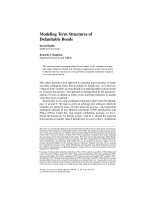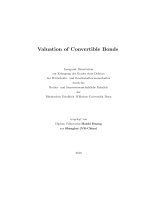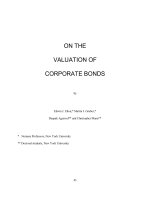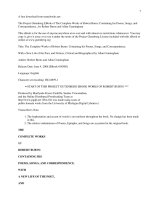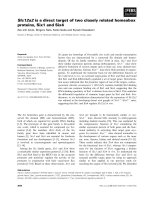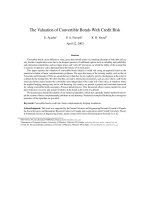Chemistry of C-C π-bonds Lectures 1-4: Alkenes, Alkynes and Conjugation doc
Bạn đang xem bản rút gọn của tài liệu. Xem và tải ngay bản đầy đủ của tài liệu tại đây (6.41 MB, 39 trang )
Chemistry of C-C π-bonds
Lectures 1-4: Alkenes, Alkynes and Conjugation
Handout 1
Handouts will be available at:
Dr Martin Smith
Office: CRL 1
st
floor 30.087
Telephone: (2) 85103
Email:
“When an unsymmetrical alkene
combines with a hydrohalic acid, the halogen
adds on to the carbon atom containing the
fewer hydrogen atoms, that is the carbon that
is more under the influence of other carbons.
I cannot here enter into a detailed
examination of the various facts that permit us
to establish such a law.”*
*Markovnikov, V. V. Ann. 1870, 153, 228.
The Chemistry of C-C
π
-Bonds - 2 -
Alkene and Alkyne chemistry I
Alkene chemistry
Structures and influence of orbitals on reactivity: How do alkenes react and why?
Typical reactions of alkenes: Nucleophilic reactions
Electrophilic reactions
Pericyclic reactions
Recap of methods for alkene generation
Recap of frontier molecular orbitals for simple reactions
Reactions of alkenes:
(i) electrophilic addition: HBr/ionic
Br
2
HOBr (anti- attack)
epoxidation
acyloxymercuration
Hydroboration - oxidation
(ii) pericyclic additions: Ozonolysis of alkenes and reductive cleavage
Diels-Alder
OsO
4
(iii) free radical additions allylic bromination (comparison with ionic)
(iv) catalytic hydrogenation reduction to alkanes
Alkyne chemistry
Structures and influence of orbitals on reactivity: How do alkynes react and why?
Electrophilic additions – comparison of reactivity with alkenes: Hydration
Alkylation
Reduction
Conjugation and delocalization in non-aromatic systems
Effects of π-bond on structure and reactivity.
Structures of conjugated alkenes and alkynes.
MO approach to conjugated systems: the allylic cation, allylic radical and butadiene
Allylic bromination
Modifications to reactivity as a result of conjugation.
Conjugate addition reactions: catalysed by acid or by base
Kinetic and thermodynamic (1,2 va 1,4 addition)
Reactions controlled by charge
Reactions controlled by orbitals
The effect of the nucleophile: hard and soft nucleophiles and electrophiles
The effect of the electrophile
Books
“Organic Chemistry”, Clayden, Greeves, Wothers and Warren, OUP, 2000.
Comments, questions and queries welcome.
The Chemistry of C-C
π
-Bonds - 3 -
The most important feature of alkenes is the π bond
Alkenes possess !-bonds and "-bonds
H
H
H
H
H
H
C-C !-bond
350 kJ mol
-1
C-C "-bond
260 kJ mol
-1
133 pm
108 pm
A π-bond is made up of two 2p orbitals
A !-orbital results from a combination of two 2p orbitals of two carbon atoms
parallel
not parallel
!-orbital
!"-orbital
two p orbitals
A consequence of the overlap of p orbitals is restricted rotation and isomerism
Br Cl
Cl
I I
Br
The Chemistry of C-C
π
-Bonds - 4 -
Alkenes may be made by elimination reactions (Prof. Dixon’s course).
1. The E2 elimination: concerted and can be stereospecific
H
X
B
H
X
H
X
2. The E1 elimination: stepwise, via carbocationic intermediate
X
R
1
R
2
R
3
R
2
R
1
H
H
H
cation stabilized by !"
and/or #-conjugation
3. The E1
CB
elimination: stepwise, via anionic intermediate
OHO OHO
need an EWG
O
conjugated product
[HO
-
leaving group]
H
B
-
Alkenes may be made by the Wittig reaction (Prof. Donohoe’s course).
H
O
R P
Ph
Ph
Ph
R
Ph
P
Ph
Ph
O
ylidcarbonyl
The Chemistry of C-C
π
-Bonds - 5 -
Typical modes of reaction of alkenes [1]. Nucleophilic
E
+
O
E
+
NR
2
E
+
Alkenes can be electron-rich and are therefore nucleophilic
alkene enolateenamine
O
E
+
R
enol ether
Typical modes of reaction of alkenes: [2]. Electrophilic
E
+
R
Alkenes can be electron-poor and electrophilic
alkene
when R is
electron
donating, the
alkene is
nucleophliic
O
OEt
O
OEt
Nu
Nu
In this case R = CO
2
Et
Typical modes of reaction of alkenes: [3]. Pericyclic
H
H
O
O
O
H
Diene Dienophile
The Chemistry of C-C
π
-Bonds - 6 -
Interactions between molecules: HOMO and LUMO – a recap
HOMO = highest occupied molecular orbital
LUMO = lowest unoccupied molecular orbital
filled orbital
of molecule 1
vacant orbital
on molecule 2
When two orbitals are brought together they can interact
to form new molecular orbitals.
In order for these two orbitals to interact they must:
If these requirements are met, then the two electrons will prefer to occupy the new
bonding orbital (as it is lower in energy) and the result is a covalent bond.
For alkene modes of reactivity:
E
+
R
For electron-poor alkene
O
OEt
O
OEt
Nu
Nu
For electron-rich alkene
R
E
(+)
The Chemistry of C-C
π
-Bonds - 7 -
Reactions of electron rich alkenes: electrophilic addition reactions
1. Bromination of alkenes
Br Br
! on alkene
"# Br-Br
Br
bromonium
cation
Br
Br
-
lone pair
"# C-Br
Br
Br
dibromide product
S
N
2
inversion
The bromonium ion is an intermediate - this means it can be observed, and in special
cases, isolated. Note this is distinct from a transition state (which is a hypothetical state
in between bond-breaking and bond-forming).
Overall: anti- addition of Br
2
across the double bond
Bromination of alkenes is stereospecific
Book Definition: “A reaction is termed stereospecific if starting materials differing only
in their configuration are converted into stereoisomeric products”
This is useful if we relate it to mechanism and hence a pragmatic working definition is:
Br Br
Br
bromonium
cation
Br
Br
Br
dibromide product
S
N
2
inversion
Bromination of cyclohexene gives only the anti- diastereoisomer – stereospecific?
[but we cannot make the trans-cyclohexene]
The Chemistry of C-C
π
-Bonds - 8 -
To check for stereospecificity we need to see if alkene geometry is reproduced in the
products – examine both cis- and trans- but-2-ene:
S
N
2
inversion
Me
H
Br
HMe
Br Br
Br
Me H
HMe
Br
Br
Br
Br
S
N
2
inversion
H
Me
Br
HMe
Br Br
Br
H Me
HMe
Br
Br
Br
Br
C
2
symmetric
dibromide
cis-
alkene
trans-
alkene
meso
dibromide
redraw
redraw
2. Reaction with bromine in water: opening of unsymmetrical bromonium ions
Br Br H
2
O H Br HO Br
Several species can function as brominating agent:
Br X
[ X = Br, HO, H
2
O ]
! on alkene
"# Br-X
Ph
Br
X
Ph
Br
H
2
O
Ph
OH
Br
S
N
2
inversion
attack at most
hindered end (why?)
(i)
(ii)
The Chemistry of C-C
π
-Bonds - 9 -
Development of charge in the transition state can affect regioselectivity
development of charge
stabilized by phenyl group
(more heavily substituted)
Ph
Br
H
2
O
Ph
OH
Br
S
N
2
inversion
Ph
Br
HO
H
[see epoxide opening from Prof Dixon’s Course for a similar situation]
A similar reaction can be performed with mercury(II) acetate ‘acyloxymercuration’
! on alkene
Ph
Hg
OAc
Ph
Hg
H
2
O
Ph
OH
HgOAc
S
N
2
inversion
AcO
OAc
NaBH
4
Ph
OH
H
Overall: Addition of water across the double bond (compare with hydroboration)
4. Reaction with HBr: Regioselectivity
Ph
HBr
Ph
H
Br
HBr
Br
The Chemistry of C-C
π
-Bonds - 10 -
Relate to mechanism of the reaction - initial protonation to give the most stable cation:
Ph
HBr
Ph
H
Br
HBr
Br
Ph
H
H
H
H
Radical Bromination: opposite regiochemistry to ionic process (why?)
Br
Br
Relate to mechanism of the reaction:
O
Ph
O
Ph
O
O
Initiation
Ph
O
O
Ph
O
O
Initiation facilitated by breaking of weak bond
H Br
Ph
O
O
+
Br
Propagation
Ph
O
O
H
The Chemistry of C-C
π
-Bonds - 11 -
We break weak bonds and make strong bonds in the propagation step
Br
Br
H Br
Br
H
Br
Regiochemistry is dictated by addition of the bromine radical
to generate the most stable radical
5. Reaction With Peracids: Stereospecific Epoxidation
O O
H R
O
O O
H R
O
O
+ RCO
2
H
HOMO
LUMO
The Chemistry of C-C
π
-Bonds - 12 -
6. Hydroboration: stereospecific syn-addition of the B-H bond across an alkene
Notes: (and so can act as a Lewis acid or an electrophile)
Mechanism of hydroboration:
BH
HOMO
LUMO
BH
LUMO
HOMO
The alkene reacts with the electron
deficient boron leading to
development of positive charge on the
more subsituted carbon
and at about the same time the
developing cation on the more
substituted carbon attacks the
hydride, which is thus delivered syn.
Application of hydroboration to a useful reaction: addition of H
2
O across an alkene
H
B
H H
B
H
B
H
H
H
H
H
repeat x 2
The Chemistry of C-C
π
-Bonds - 13 -
B
H
B
H
H
R
R
H
draw as
OH
H
We can oxidize the borane to an alcohol whilst maintaining the stereochemistry of
the hydroboration.
Mechanism:
B
H
R
R
B
H
H
2
O
2
+ HO
-
HOO
-
+ H
2
O
-
OOH
R
R
O
OH O
H
B
R
R
Repeat x 2
O
H
B
OR
OR
HO
-
O
H
B
O
OR
OR
H
-
OH
OH
H
Overall: syn addition of water across the double bond (compare with
acyoxymercuration/reduction)
The Chemistry of C-C
π
-Bonds - 14 -
Pericyclic reactions involving alkenes
6. Pericyclic reactions: Reaction with Ozone and subsequent reduction
(a useful method for the cleavage of C=C bonds)
R
O
O
O
HOMO
LUMO
O
O
O
R
R
O
O
O
R
O
O
O
redraw
R
O
O
O
R O
O
O
PPh
3
(or SMe
2
)
R
O
O
Ph
P
Ph
O
Ph
R
R
O
Overall:
A useful way to ‘unmask’ a carbonyl group
The Chemistry of C-C
π
-Bonds - 15 -
7. Pericyclic reactions: Reaction with Osmium tetroxide
R
1
R
2
R
1
R
2
OH
OH
Mechanism:
R
1
R
2
Os
O
O
O
O
R
1
R
2
R
1
R
2
O
Os
O
O
O
H
2
O
R
1
R
2
OH
OH
OH
Os
HO
O
O
N
O
O
reoxidant:
because the reaction demands a specific
stereochemical outcome (a consequence of the concerted 1,3-dipolar cycloaddition).
R
1
R
2
R
1
R
2
OH
OH
Rotate
R
1
OH
R
2
OH
R
1
R
1
R
2
OH
OH
Rotate
R
1
OH
R
2
OH
R
2
The Chemistry of C-C
π
-Bonds - 16 -
8. Pericyclic reactions: The Diels-Alder reaction
A great way to make complex six membered rings
H
H
O
O
O
H
Diene Dienophile
Diene
Dienophile
Key features: (1). We need a diene in which the C=C bonds can orient cis to
each other
(3). The reaction is concerted and pericyclic
CN
NC
NC
CN
Diene
Dienophile
CN
CN
redraw
Tip: draw reaction
product in the same
orientation as the
transition state
This reaction is effective because: (1).
(2).
The Chemistry of C-C
π
-Bonds - 17 -
9. Reduction: alkene can be reduced to alkanes by hydrogenation
R
1
R
2
R
1
R
2 R
1
R
2
The two hydrogen atoms are often added to the SAME face of the alkene:
Me
Me
Me Me
H H
Me Me
H H
Me
Me
H
H
redraw
This means we get overall cis reduction of the alkene
The Chemistry of C-C
π
-Bonds - 18 -
Alkynes
Alkynes have two π-bonds that are orthogonal
R
1
R
2
R
1
R
2
See Prof Dixon’s course for methods to make alkynes via elimination of haloalkenes.
Reduction
R
1
R
2
R
1
R
2
R
1
R
2
(1): cis selective reduction of alkynes
Key point: The alkyne is more susceptible to hydrogenation than the alkene
R
1
R
2
R
1
R
2
H H
H
H
Both hydrogens are added to the alkyne simultaneously
and hence the cis alkene is produced
The Chemistry of C-C
π
-Bonds - 19 -
Trans- selective reduction
R
1
R
2
Na
NH
3
(l)
R
1
R
2
N
H
HH
R
1
R
2
H
NH
3
(l)
R
1
R
2
H
R
1
R
2
H
H
Sodium is the reducing agent in this reaction, and ammonia is capable of functioning as
a proton source.
Alkylation (and isomerization)
H
H
H
H
H
H
H
H
H
H
H
H
H
H
H
H
H
H
H
H
H
The significantly increased acidity of alkynes is synthetically useful
for functionalization of alkynes:
H
R
R
strong base
Li
R
1
I
S
N
2
R
R
1
The Chemistry of C-C
π
-Bonds - 20 -
Application of alkyne alkylation to the synthesis of billion dollar anti AIDS medicine:
N
H
O
Cl
O
CF
3
Efavirenz (Merck)
front line HIV treatment
approx $1 billion in sales
in 2008
small, but key
component
Synthesis:
HH
LiH
Cl
ClBr
Cl
H
Strong base
(pKa approx 45)
BuLi
Cl
S
N
2
BuLi
Intramolecular
substitution
(ring closure)
The Chemistry of C-C
π
-Bonds - 21 -
Hydration of alkynes with Mercury (II) acetate (compare with alkenes)
H
R
! on alkyne
Hg
OAcAcO
R
Hg
OAc
H
2
O
H
2
O
HO
HgOAc
R
H
O
HgOAc
R
H
O
R
H
H
O
R
H
+
H
+
H
+
X
-
H
+
A useful reaction that leads to the production of ketones from terminal alkynes
Isomerization of alkynes
H
KOH/ROH
heat
pKa 25
pKa 16
(i). Disubstitutued alkynes are thermodynamically more stable than monosubstituted
(ii). Terminal alkynes are the most acidic protons
Mechanism: use a reversible base to get the thermodynamic product.
H
H
OR
H
OR
H
OR
H
OR
The Chemistry of C-C
π
-Bonds - 22 -
Conjugation and has effects on reactivity and reaction outcome
OH
Br
Br
OH
Kinetic product
distribution
Thermodynamic product
distribution
The same ratio of products is obtained regardless
of which allylic alcohol we start with – why?
Mechanism:
OH
OH
OH
2
OH
2
Br
Br
Br-
The allyl cation can be represented in several different ways:
1/2+ 1/2+
The allyl cation is a delocalized system with the charge shared between the two
carbons at the end of the system.
How can we consider this in terms of molecular orbitals?
The Chemistry of C-C
π
-Bonds - 23 -
Molecular orbital picture of the allyl cation
We can consider this as an extension of the simple picture covered on p3:
!-orbital
combine
'in phase'
2 electrons
in a ! bond
vacant
p-orbital
The easiest way to do this is to look at a combination of THREE p-orbitals,
which will lead to THREE molecular orbitals
The picture is very similar to the picture for the formation of a π-bond outlined on p3
three
degenerate
p-orbitals
SAME
energy
NONBONDING
HOMO
LUMO
increasing
energy
Once we place the electrons in the orbitals in increasing energy, we can examine the
picture and relate it to the reactivity we observe
LUMO
This orbital picture is consistent with what we
observe - attack on the two 'ends' of the cation
The Chemistry of C-C
π
-Bonds - 24 -
A summary of the allyl cation:
1. The two bonding electrons in the π-system are spread out over all three atoms
‘delocalized’ (with most electron density on the central carbon)
2.
3. Both end carbons are equivalent – the LUMO shows that the ends are the site for
attack by a nucleophile
4.
We can use essentially the same system to describe allylic radical bromination
H
N
O O
Br
(compare with anionic bromination discussed on p 7)
Mechanism:
Step 1: N-bromo succinimide is a source of molecular bromine
N
O
O
Br
N
O
O
Br N
O
O
Br
H
Br
NH
O
O
Br
2
Br
2
Br
NH
O
O
The Chemistry of C-C
π
-Bonds - 25 -
Step 2: Hydrogen abstraction to give the most stable radical (compare with the other
radical process we’ve covered on p 10).
Br Br
Br
Br
The molecular orbitals for the allyl radical are the same as for the allyl cation on p23
(but we now have to put three, rather than two electrons into the molecular orbitals)
good
overlap
poor
overlap
three
degenerate
p-orbitals
SAME
energy
NONBONDING
increasing
energy
bonding
interaction
antibonding
interaction
